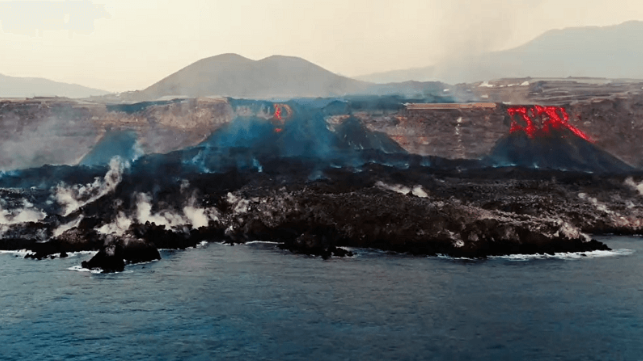The Cumbre Vieja Volcano is Making the Island of La Palma Bigger

The massive volcanic eruption on the southern end of La Palma is actually expanding the island's landmass. A molten lava flow has reached the land's end and is pouring over a cliff edge, hardening as it hits the water.
About 80 new acres have been formed so far, according to local officials, making La Palma (and Spain) ever so slightly larger. Plans for utilizing, selling or developing the extra space have not yet been announced.
The volcano has been spewing molten rock for about two weeks, but the end of the flow began moving towards the sea more quickly over the weekend. Two new vents have opened up on the side of the Cumbre Vieja caldera, sending lava gushing out at an accelerated pace.
6,000 people were evacuated in advance of the eruption, and no fatalities have been reported. The lava has destroyed an estimated 1,050 residences and other buildings, buried nearly 1,100 acres under solid rock, and cut off roads and other infrastructure in a continuous east-west line across the island's west side. The end is not yet in sight, local officials said.
"It doesn't look like it's close to ending yet, because of the millions of cubic meters of lava that the volcano is throwing out," Canary Islands President Ángel Víctor Torres told media on Sunday.
Spain's government has promised about $240 million in assistance for La Palma, including aid for rebuilding local water supply infrastructure. It will also provide employment aid for those affected by the eruption: the blast has effectively shut down the area's tourist industry, and recent photos show completely-vacant boardwalks at the popular black sand beaches of Puerto Naos, located north of the lava flow.
The volcano is also emitting tremendous amounts of sulfur dioxide into the atmosphere, and scientists expect that the pollutants will spread as far west as the Caribbean. Despite early concerns that the lava would generate large quantities of health-hazardous gases when it reached the sea, the air quality is still safe in areas that have not been evacuated, according to local officials.
No comments:
Post a Comment